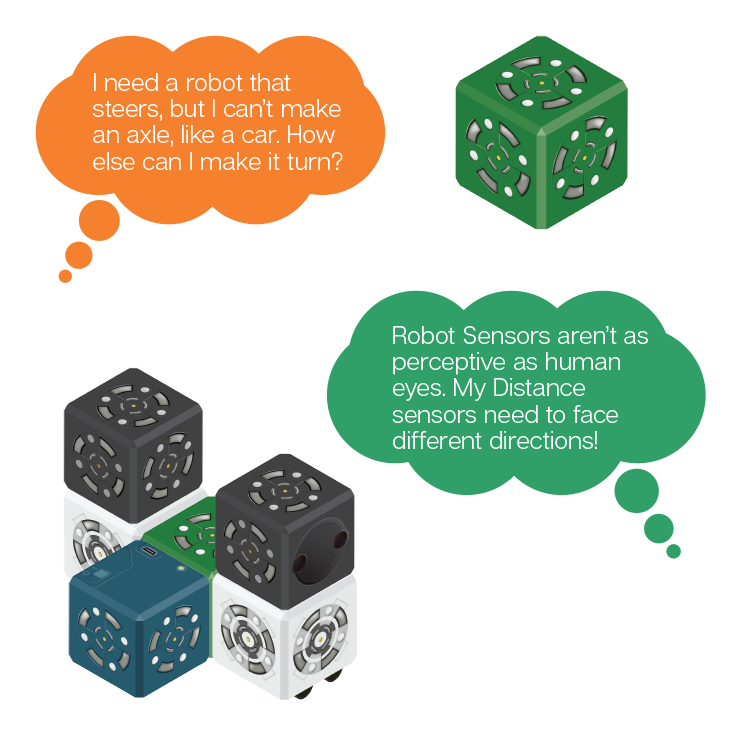By now, you’ve probably heard all about Computational Thinking. You’ve already defined it and shown how it relates to your content. But of course, Computational Thinking applies to many subjects and tools, including Cubelets.
Here at Modular Robotics, we define computational thinking as being a problem-solving process that helps break down complex problems into smaller parts, so you can develop a model to solve the problem, evaluate the results, and recreate the solution over and over! (If you’d like to learn more about our definition, check out our page devoted entirely to Computational Thinking.)
Computational Thinking is commonly divided into four subskills:
- Decomposition
- Pattern Recognition
- Abstraction
- Algorithmic Solutions
Decomposition
So how do Cubelets support students’ development of computational thinking skills? First, since Cubelets robots are modular (made of many pieces), students are automatically decomposing design challenges into their smallest parts.
Challenge: Build a robot that can solve a maze by itself.

Pattern Recognition
Pattern Recognition also comes naturally during Cubelets play. Students are constantly comparing Cubelets robots to animals, people, or vehicles they are already familiar with. In fact, many younger students interact with Cubelets robots as if they are alive by trying to give them verbal directions instead of interacting with the sensors. This is a good thing because it helps students make connections between robotics and their background knowledge of the natural world and already-invented machines.
Challenge: Build a robot that can solve a maze by itself.

Abstraction
As challenges get more complex, students are put in the position of abstracting the most important parts of a challenge away from the distracting details.
Challenge: Build a robot that can solve a maze by itself.

Algorithmic Solutions
The term “algorithmic solutions” can sound intimidating, like it requires students to have written their answers using a specific programming language or complex numerical formula, but this is a common misconception. Algorithmic solutions simply need to be logical. As students eventually learn coding languages and computer science, they will begin to use computer-specific vocabulary, but code-specific language is not a requirement for emergent algorithmic solutions.
In fact, for many students, Cubelets are a wonderful opportunity to showcase their problem-solving abilities in an unrestricted language environment. Aside from using the assigned names of specific Cubelets, we encourage students to use their own words and phrases to explain their robots. We like to call this “pseudocode” and it should include statements of cause and effect as well as sequencing. Every time students use cause-and-effect or sequencing descriptions, they are demonstrating algorithmic solutions. If you are using any sentence stems for these in your literacy units, this is an excellent crossover!
Finally, one of the most important practices behind every content area, from reading to computer science, is the ability to persevere through challenges. One of the great things about Cubelets is that, time and time again, we see students more engaged during Cubelets design challenges than during any other activity. In fact, as you can tell from our other blog posts, Cubelets are so engaging they can create a classroom management conundrum. But unlike other times where classroom management may slip, Cubelets engage students in investigations and inventions that keep them on task.
Computational Thinking is a fundamental part of every Cubelets design experience. By disguising the learning within engaging design challenges, you can reach even your most reluctant learners and provide targeted interventions to support all students in developing effective computational thinking strategies.
Enjoyed this blog post? Sign up for the #CubeletsChat newsletter to receive the next blog post straight to your inbox. Plus join the discussion on twitter using the #CubeletsChat hashtag!


